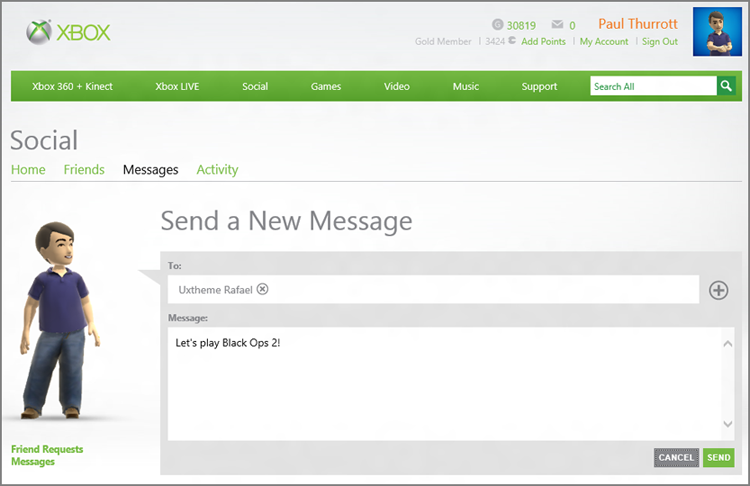|
Xbox LIVE began in 2002 as a feature of the original Xbox console. It was an offshoot of the multiplayer features in the first Halo
game, and essentially formalized those features across an online
network that other games could then use. But the Xbox LIVE service as
we now know it appeared in 2005 alongside the Xbox 360, Microsoft’s
second video game console. At that time, Microsoft greatly enhanced
Xbox LIVE, providing the core capabilities and experiences that Xbox
360 gamers—and Windows Phone and now Windows 8 games gamers—still enjoy
today.
NOTE Video
game historians will note that the first video game console Microsoft
contributed to was the Sega Dreamcast. But when the Windows CE-based
environment in that console proved unpopular with game developers,
Microsoft took things into its own hands and created the Xbox.
Many of these third-party services, of course, require a separate subscription as well.
Microsoft also offers two types of Xbox LIVE
accounts: a free account that’s simply called Xbox LIVE and a paid
account called Xbox LIVE Gold. Xbox LIVE Gold members pay about $50 a
year and are rewarded with some unique features. Looking just at the
Xbox 360 console, gamers who opt for the Gold subscription get online
multiplayer gaming, party and party chat functionality, and video chat
capabilities. But they also get access to many multimedia services,
including Netflix, Hulu Plus, HBO GO, Sky Player (UK only), Last.fm
Internet music streaming, Xbox Music and Video services, and a lot more.
CROSSREF
Microsoft’s Xbox entertainment services, Xbox Music and Xbox Video,
used to utilize the Zune brand.
Microsoft account used to be called Windows Live ID.
Signing up for Xbox LIVE is one of many ways in which you can create a Microsoft account.
(Other popular methods include signing up for Hotmail or the Xbox Music
Pass subscription.) Xbox LIVE, like other Microsoft services and, now,
Windows 8, uses the same underlying identification service. So at the
time of sign-up, you can use your own e-mail account, no matter where
it’s from, and Xbox LIVE will convert that e-mail address into a
Microsoft account. Or, if you already have a Microsoft account through
Hotmail, MSN, or wherever, you can simply use your existing account.
For purposes of this discussion, we’ll assume that you’ve created a
Microsoft account, since you’ll be using this same account for gaming
purposes on Windows 8, just as you do on the Xbox 360 (and Windows
Phone).
Next, let’s examine what your Xbox LIVE account provides.
Xbox LIVE Accounts
Microsoft’s Xbox LIVE service is always
changing, so it’s possible and even likely that there will be
additional features offered in addition to what’s outlined here.
Your Xbox LIVE account is your online
persona on that online service, the thing that represents you in
whatever virtual worlds you decide to use. Each Xbox LIVE account consists of the following general features:
- Gamertag: This
is your identity, or name, on Xbox LIVE, and it will be the same name
you previously established for your Microsoft account. If you’re not
happy with this name, you can change it at any time, but Microsoft
charges $10 each time in order to prevent kids from constantly changing
their names while playing games. Yes, really.
- Gamer Zone: This item describes what type of gamer you are and can be set to Recreation, Pro, Family, or Underground.
- Gamer Picture: This
is a small, usually simple picture that represents you online.
Subscribers to the free Xbox LIVE service have one Gamer Picture, which
is shown to all users, while Xbox LIVE Gold gamers can have two: one
for friends and one for the general populace. (See? That $50 annual fee
does make sense.) If you have a video
camera add-on for the Xbox 360 console, you can use that to take a
still photo of yourself as a gamer picture, but only for friends to see.
- Motto: This is a 21-character textual representation of who you are and what you stand for. I’ve used such bon mots as The end is listless and Pwned.
- Avatar: Based
largely on the Nintendo Wii’s similar Mii characters, an avatar can be
designed to look (somewhat) like you, albeit a slightly rotund and
cartoonish you. A typical avatar is shown in Figure 1.
Figure 1: Cartoonish avatars are now used to represent your Xbox LIVE identity online.

- Name: This can be your real name or a nickname.
- Bio: A text box providing up to 499 characters for describing your history or other relevant information.
Just a common sense bit of advice: Don’t be too specific with your location.
- Location: A text field with up to 40 characters of space for describing your general location.
- Privacy Settings: You
have fine-grained control over various privacy settings, including
those related to voice and text, camera, profile, online status, video
status, friends list, game history, member content, Xbox marketing, and
partner marketing.
- Profile: Your
Xbox LIVE profile consists of the Gamertag, Gamer Zone, Gamer Picture,
Motto, Avatar, Name, Bio, Location, and privacy settings information
described previously.
- Rep: This
is your rep, or reputation score, on a scale of one to five. Every Xbox
LIVE member starts with a rep of 3, but it can go up or down from there
based on your experience (where the more you play, the higher the rep)
and whether any other gamers complain about you online (the more you
misbehave, the more people complain, and the more your rep declines).
- Gamerscore: Each
Xbox LIVE game can assign Gamer Points to individual achievements, as
we’ll soon discuss. These points are applied to your Gamerscore, which
starts at 0 when you open the account. The higher your Gamescore, the
more experienced you are, generally speaking, though many hard-core
gamers only play in multiplayer matches that don’t provide multiplayer
achievements and thus might have deceptively low Gamerscores. Likewise,
those with higher Gamerscores could be achievement point addicts, or
even cheating.
- Gamercard: Your
Xbox LIVE Gamercard combines your Gamertag, Gamer Picture, Rep,
Gamerscore, and Gamer Zone into a single, easily viewable overview of
your Xbox LIVE account, or gamer persona.
- Messages: Using
an e-mail-like system, Xbox LIVE members can send messages to each
other using text, audio, and video. These messages aren’t ever
broadcast via normal e-mail systems (via the e-mail associated with
your Microsoft account), but you can view and respond to received
messages, and create new ones, on the Xbox 360 and via the Xbox
website, as shown in Figure 2.
- Friends list:
As with Facebook and other social networking services, you can “friend”
other people online, send and receive friend requests, see what your
friends are doing online in real time, send messages to friends, and
more. The Xbox LIVE Friends list is sorted by online status, so that
online friends are listed first.
Figure 2: You can access the Xbox LIVE Messages functionality via the web.

- Players list: Xbox
LIVE tracks the players you’ve most recently played against so you can
find them again later and request a rematch, send feedback (positive or
negative), or send a friend request.
- Games list: Xbox
LIVE also tracks the games you’ve most recently played on the Xbox 360,
Windows Phone, and Windows 8, as well as the achievements you’ve most
recently earned, including all of the achievements earned in each
played game. Friends can examine your account to see which games you’ve
played, and which achievements you’ve earned, and compare them to their
own results.
Xbox LIVE and Xbox LIVE Arcade Games and Achievements
If you’re an avid game player, one of
the best reasons to join Xbox LIVE is, well, the games. And among the
cream of the crop are those games that get people together so they can
compete against each other online.
On the Xbox 360, the most common of these types of games, the multiplayer games, are online shooters, such as those in the Call of Duty, Gears of War, and Halo
series. But there are many other wildly popular online game types on
Xbox LIVE as well, including real-time strategy, racing, and, Kinect
titles, the latter of which use that device’s motion-sensing and voice
technologies to provide unique experiences.
Aside from facing off against your friends and
others, Xbox LIVE also offers an achievements system in which games can
offer between 200 and 1,000 achievement points, usually via a large
number of individual achievements. When you do trigger an
achievement—perhaps by completing an in-game level or other task— the
console displays the ever-popular Achievement Unlocked notification,
providing the name of the achievement. You can tap a button on the Xbox
360 controller to learn more, including how many achievement points
you’ve earned and the description of the achievement. You can also view
your overall Gamerscore to see how the achievement points affected
things.
How Many Points?
Although 200 to 1,000 achievement points seems like a wide range, it is, in fact, even wider than that.
Xbox LIVE games for Windows Phone, and
Xbox LIVE Arcade titles, which tend to be shorter and much less
expensive than normal Xbox LIVE titles, typically provide 200
achievement points that can be spread out over up to 12 individual
achievements. Retail Xbox LIVE games for the Xbox 360 and Windows 8
typically provide 1,000 achievement points, which can occur over as
many as 50 individual achievements. But Microsoft has also expanded the
achievement points system for those game makers that wish to support
their games with add-on packs that extend gameplay and provide new
features. For those games, it’s possible to have as many as 1,750
achievement points, over as many as three separate add-on packs.
Xbox LIVE games also support a feature
called leaderboards, which are ranked lists that are relevant to the
individual game. In a shooter like those in the Call of Duty
series, for example, there are leaderboard lists for most overall
points, most overall victories, most victories per game type, and so on.
|